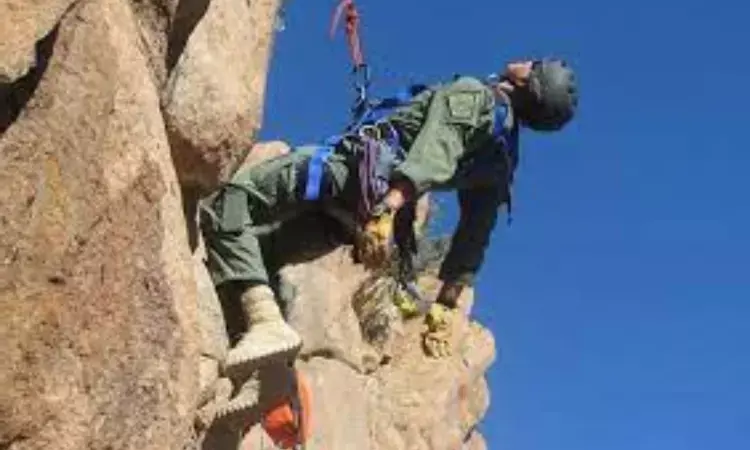- Home
- Medical news & Guidelines
- Anesthesiology
- Cardiology and CTVS
- Critical Care
- Dentistry
- Dermatology
- Diabetes and Endocrinology
- ENT
- Gastroenterology
- Medicine
- Nephrology
- Neurology
- Obstretics-Gynaecology
- Oncology
- Ophthalmology
- Orthopaedics
- Pediatrics-Neonatology
- Psychiatry
- Pulmonology
- Radiology
- Surgery
- Urology
- Laboratory Medicine
- Diet
- Nursing
- Paramedical
- Physiotherapy
- Health news
- Fact Check
- Bone Health Fact Check
- Brain Health Fact Check
- Cancer Related Fact Check
- Child Care Fact Check
- Dental and oral health fact check
- Diabetes and metabolic health fact check
- Diet and Nutrition Fact Check
- Eye and ENT Care Fact Check
- Fitness fact check
- Gut health fact check
- Heart health fact check
- Kidney health fact check
- Medical education fact check
- Men's health fact check
- Respiratory fact check
- Skin and hair care fact check
- Vaccine and Immunization fact check
- Women's health fact check
- AYUSH
- State News
- Andaman and Nicobar Islands
- Andhra Pradesh
- Arunachal Pradesh
- Assam
- Bihar
- Chandigarh
- Chattisgarh
- Dadra and Nagar Haveli
- Daman and Diu
- Delhi
- Goa
- Gujarat
- Haryana
- Himachal Pradesh
- Jammu & Kashmir
- Jharkhand
- Karnataka
- Kerala
- Ladakh
- Lakshadweep
- Madhya Pradesh
- Maharashtra
- Manipur
- Meghalaya
- Mizoram
- Nagaland
- Odisha
- Puducherry
- Punjab
- Rajasthan
- Sikkim
- Tamil Nadu
- Telangana
- Tripura
- Uttar Pradesh
- Uttrakhand
- West Bengal
- Medical Education
- Industry
ICAR MEDCOM releases Experts recommendations on suspension syndrome

Italy: A recent article published in the Scandinavian Journal of Trauma, Resuscitation and Emergency Medicine reports a scoping review and recommendations from the International Commission for Mountain Emergency Medicine (ICAR MEDCOM) on suspension syndrome. Suspension syndrome is a rare form of cardiovascular collapse that can affect climbers and rope workers.
The authors recommend that rope work should never be conducted alone due to the risk of suspension syndrome. Patients should be laid horizontally immediately upon rescue, followed by basic and advanced life support. Authors call for an international case registry.
Suspension syndrome occurs when a person suspended vertically in, eg, a climbing harness experiences cardio-circulatory collapse. The diminished preload has been speculated to be the cause, there is no proper understanding of the syndrome and optimal treatment. People at risk include rope access technicians, cavers, height rescue workers, and sport climbers.
In a systematic review, the ICAR MEDCOM found 23 articles addressing suspension syndrome. Simon Rauch, Institute of Mountain Emergency Medicine, Eurac Research, Bolzano, Italy, and colleagues conducted a scoping review and then generated prevention, diagnosis, and treatment recommendations.
The key findings of the review are as follows:
- Incidence is unknown, but deaths are rare since sit harnesses were introduced in the 1970s.
- In experiments in healthy volunteers, suspension led, after minutes to hours, to a sudden drop in heart rate, blood pressure, and stroke volume, as well as presyncopal symptoms. This suggests a neurocardiogenic aetiology.
- Exacerbating factors have included pain, higher body weight, and previous exercise.
- Other effects of suspension include rhabdomyolysis, hyperkalaemia, ventricular arrhythmia, acute kidney injury, hypothermia, thrombi, and paraesthesia.
- Belt or chest harnesses without other loops are likelier to result in suspension syndrome, as are harnesses with a dorsal attachment.
- Patients who cannot be quickly rescued should be encouraged to activate leg muscles.
Based on the scoping review, discussion with the ICAR MedCom and to give guidance on the most important questions regarding the suspension syndrome, the following recommendations on prevention, diagnosis and treatment of the suspension syndrome have been developed and graded according to the Grading System of the American College of Chest Physicians.
Recommendations
- Rope work should be done only with proper equipment and knowledge of how to use it correctly. Rope work should never be conducted alone.
- Persons suspended in a harness should be rescued as soon as possible, even if the casualty is asymptomatic, as time to near or actual syncope and potentially cardiac arrest is variable and unpredictable
- While awaiting rescue, persons suspended freely on a rope should move their legs to reduce venous pooling.
- If no adjoining structures are in reach, foot loops should be used to step in and increase the activation of the muscle pump.
- If the casualty is no longer able to act and it is safe to do so, the first rescuer reaching the casualty should raise the victim’s legs to create a more horizontal position while measures are taken to lower the patient to the ground.
- Once the casualty is on the ground, the casualty should be positioned supine. Assessment and treatment should follow standard advanced life support algorithms. Reversible causes of cardiac arrest, including hyperkalaemia and pulmonary embolism, should be considered and managed appropriately.
- After prolonged hanging (> 2 h), patients are at risk of developing hyperkalaemia and acute kidney injury and should, therefore, be transported to a hospital with the capability of performing emergent renal replacement therapy.
The main limitation of the research was that there were no randomised controlled multinational studies.
Reference:
Rauch, S., Lechner, R., Strapazzon, G. et al. Suspension syndrome: a scoping review and recommendations from the International Commission for Mountain Emergency Medicine (ICAR MEDCOM). Scand J Trauma Resusc Emerg Med 31, 95 (2023). https://doi.org/10.1186/s13049-023-01164-z
Dr Kamal Kant Kohli-MBBS, DTCD- a chest specialist with more than 30 years of practice and a flair for writing clinical articles, Dr Kamal Kant Kohli joined Medical Dialogues as a Chief Editor of Medical News. Besides writing articles, as an editor, he proofreads and verifies all the medical content published on Medical Dialogues including those coming from journals, studies,medical conferences,guidelines etc. Email: drkohli@medicaldialogues.in. Contact no. 011-43720751


